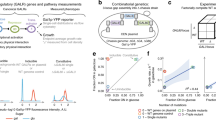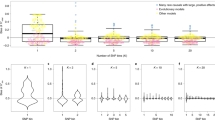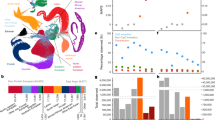Abstract
Many mutations, including those that cause disease, only have a detrimental effect in a subset of individuals. The reasons for this are usually unknown, but may include additional genetic variation and environmental risk factors1. However, phenotypic discordance remains even in the absence of genetic variation, for example between monozygotic twins2, and incomplete penetrance of mutations is frequent in isogenic model organisms in homogeneous environments3,4. Here we propose a model for incomplete penetrance based on genetic interaction networks5,6. Using Caenorhabditis elegans as a model system, we identify two compensation mechanisms that vary among individuals and influence mutation outcome. First, feedback induction of an ancestral gene duplicate differs across individuals, with high expression masking the effects of a mutation. This supports the hypothesis that redundancy is maintained in genomes to buffer stochastic developmental failure7. Second, during normal embryonic development we find that there is substantial variation in the induction of molecular chaperones such as Hsp90 (DAF-21). Chaperones act as promiscuous buffers of genetic variation8,9, and embryos with stronger induction of Hsp90 are less likely to be affected by an inherited mutation. Simultaneously quantifying the variation in these two independent responses allows the phenotypic outcome of a mutation to be more accurately predicted in individuals. Our model and methodology provide a framework for dissecting the causes of incomplete penetrance. Further, the results establish that inter-individual variation in both specific and more general buffering systems combine to determine the outcome inherited mutations in each individual.
This is a preview of subscription content, access via your institution
Access options
Subscribe to this journal
Receive 51 print issues and online access
$199.00 per year
only $3.90 per issue
Buy this article
- Purchase on Springer Link
- Instant access to full article PDF
Prices may be subject to local taxes which are calculated during checkout




Similar content being viewed by others
References
Badano, J. L. & Katsanis, N. Beyond Mendel: an evolving view of human genetic disease transmission. Nature Rev. Genet. 3, 779–789 (2002)
Baranzini, S. E. et al. Genome, epigenome and RNA sequences of monozygotic twins discordant for multiple sclerosis. Nature 464, 1351–1356 (2010)
Horvitz, H. R. & Sulston, J. E. Isolation and genetic characterization of cell-lineage mutants of the nematode Caenorhabditis elegans. Genetics 96, 435–454 (1980)
Gartner, K. A third component causing random variability beside environment and genotype. A reason for the limited success of a 30 year long effort to standardize laboratory animals? Lab. Anim. 24, 71–77 (1990)
Lehner, B., Crombie, C., Tischler, J., Fortunato, A. & Fraser, A. G. Systematic mapping of genetic interactions in Caenorhabditis elegans identifies common modifiers of diverse signaling pathways. Nature Genet. 38, 896–903 (2006)
Costanzo, M. et al. The genetic landscape of a cell. Science 327, 425–431 (2010)
Nowak, M. A., Boerlijst, M. C., Cooke, J. & Smith, J. M. Evolution of genetic redundancy. Nature 388, 167–171 (1997)
Rutherford, S. L. & Lindquist, S. Hsp90 as a capacitor for morphological evolution. Nature 396, 336–342 (1998)
Queitsch, C., Sangster, T. A. & Lindquist, S. Hsp90 as a capacitor of phenotypic variation. Nature 417, 618–624 (2002)
Elowitz, M. B., Levine, A. J., Siggia, E. D. & Swain, P. S. Stochastic gene expression in a single cell. Science 297, 1183–1186 (2002)
Wernet, M. F. et al. Stochastic spineless expression creates the retinal mosaic for colour vision. Nature 440, 174–180 (2006)
Chang, H. H., Hemberg, M., Barahona, M., Ingber, D. E. & Huang, S. Transcriptome-wide noise controls lineage choice in mammalian progenitor cells. Nature 453, 544–547 (2008)
Raj, A., Rifkin, S. A., Andersen, E. & van Oudenaarden, A. Variability in gene expression underlies incomplete penetrance. Nature 463, 913–918 (2010)
Eldar, A. et al. Partial penetrance facilitates developmental evolution in bacteria. Nature 460, 510–514 (2009)
Lehner, B. Genes confer similar robustness to environmental, stochastic, and genetic perturbations in yeast. PLoS ONE 5, e9035 (2010)
Andachi, Y. Caenorhabditis elegans T-box genes tbx-9 and tbx-8 are required for formation of hypodermis and body-wall muscle in embryogenesis. Genes Cells 9, 331–344 (2004)
Pocock, R., Ahringer, J., Mitsch, M., Maxwell, S. & Woollard, A. A regulatory network of T-box genes and the even-skipped homologue vab-7 controls patterning and morphogenesis in C. elegans. Development 131, 2373–2385 (2004)
Baugh, L. R. et al. Synthetic lethal analysis of Caenorhabditis elegans posterior embryonic patterning genes identifies conserved genetic interactions. Genome Biol. 6, R45 (2005)
Kafri, R., Bar-Even, A. & Pilpel, Y. Transcription control reprogramming in genetic backup circuits. Nature Genet. 37, 295–299 (2005)
DeLuna, A., Springer, M., Kirschner, M. W. & Kishony, R. Need-based up-regulation of protein levels in response to deletion of their duplicate genes. PLoS Biol. 8, e1000347 (2010)
Koh, K. & Rothman, J. H. ELT-5 and ELT-6 are required continuously to regulate epidermal seam cell differentiation and cell fusion in C. elegans. Development 128, 2867–2880 (2001)
Bateson, W. Mendel’s Principles of Heredity (Cambridge Univ. Press, 1909)
Ow, M. C. et al. The FLYWCH transcription factors FLH-1, FLH-2, and FLH-3 repress embryonic expression of microRNA genes in C. elegans. Genes Dev. 22, 2520–2534 (2008)
Vavouri, T., Semple, J. I. & Lehner, B. Widespread conservation of genetic redundancy during a billion years of eukaryotic evolution. Trends Genet. 24, 485–488 (2008)
Tischler, J., Lehner, B., Chen, N. & Fraser, A. G. Combinatorial RNA interference in Caenorhabditis elegans reveals that redundancy between gene duplicates can be maintained for more than 80 million years of evolution. Genome Biol. 7, R69 (2006)
Lehner, B. Conflict between noise and plasticity in yeast. PLoS Genet. 6, e1001185 (2010)
Waddington, C. H. Canalization of development and the inheritance of acquired characters. Nature 150, 563–565 (1942)
Bobula, J. et al. Why molecular chaperones buffer mutational damage: a case study with a yeast Hsp40/70 system. Genetics 174, 937–944 (2006)
Van Dyk, T. K. G. A. LaRossa RA. Demonstration by genetic suppression of interaction of GroE products with many proteins. Nature 342, 451–453 (1989)
Tokuriki, N. & Tawfik, D. S. Chaperonin overexpression promotes genetic variation and enzyme evolution. Nature 459, 668–673 (2009)
Abramoff, M. D., Magelhaes, P. J. & Ram, S. J. Image processing with ImageJ. Biophoton. Int. 11, 36–42 (2004)
Wolf, D. E., Samarasekera, C. & Swedlow, J. R. Quantitative analysis of digital microscope images. Methods Cell Biol. 81, 365–396 (2007)
Sing, T., Sander, O., Beerenwinkel, N. & Lengauer, T. ROCR: visualizing classifier performance in R. Bioinformatics 21, 3940–3941 (2005)
Brenner, S. The genetics of Caenorhabditis elegans. Genetics 77, 71–94 (1974)
Kelly, W. G., Xu, S., Montgomery, M. K. & Fire, A. Distinct requirements for somatic and germline expression of a generally expressed Caernorhabditis elegans gene. Genetics 146, 227–238 (1997)
Mitani, S. Genetic regulation of mec-3 gene expression implicated in the specification of the mechanosensory neuron cell types in Caenorhabditis elegans. Dev. Growth Differ. 37, 551–557 (2003)
Praitis, V., Casey, E., Collar, D. & Austin, J. Creation of low-copy integrated transgenic lines in Caenorhabditis elegans. Genetics 157, 1217–1226 (2001)
Wilm, T., Demel, P., Koop, H. U., Schnabel, H. & Schnabel, R. Ballistic transformation of Caenorhabditis elegans. Gene 229, 31–35 (1999)
Yamaguchi, Y., Murakami, K., Furusawa, M. & Miwa, J. Germline-specific antigens identified by monoclonal antibodies in the nematode Caenorhabditis elegans. Dev. Growth Differ. 25, 121–131 (1983)
Raj, A., van den Bogaard, P., Rifkin, S. A., van Oudenaarden, A. & Tyagi, S. Imaging individual mRNA molecules using multiple singly labeled probes. Nature Methods 5, 877–879 (2008)
Sage, D., Neumann, F. R., Hediger, F., Gasser, S. M. & Unser, M. Automatic tracking of individual fluorescence particles: application to the study of chromosome dynamics. IEEE Trans. Image Process. 14, 1372–1383 (2005)
Acknowledgements
This work was funded by grants from the European Research Council, Institució Catalana de Recerca i Estudis Avançats, Ministerio de Ciencia e Innovación Plan Nacional BFU2008-00365, Agència de Gestió d’juts Universitaris i de Recerca, ERASysBio+, the European Molecular Biology Organization Young Investigator Programme, the EMBL-CRG Systems Biology Program, by a Formación de Personal Investigador–Ministerio de Ciencia e Innovación fellowship to A.B. and by a Beatriu de Pinós Fellowship to M.O.C. We thank I. Hope, V. Ambros and S. Kim for providing strains. Additional strains were obtained from the Caenorhabditis Genetics Center, which is funded by the National Institutes of Health National Center for Research Resources. We thank T. Zimmermann and R. García from the CRG Advanced Light Microscopy Unit for advice and assistance, J. Miwa and Y. Yamaguchi for 608F antibody, J. Semple for providing complementary DNA clones, A. Marchetti and R. García-Verdugo for technical assistance, J. Tischler and C. Kiel for advice on single-molecule fluorescence in situ hybridization and western blotting, respectively, and L. Serrano, M. Isalan and J. Semple for comments on the manuscript.
Author information
Authors and Affiliations
Contributions
A.B. performed all experiments, developed the method and analysed the data; M.O.C. demonstrated that increased chaperone activity can suppress mutation outcome in C. elegans; A.B. and B.L. designed experiments, conceived the model and wrote the manuscript.
Corresponding author
Ethics declarations
Competing interests
The authors declare no competing financial interests.
Supplementary information
Supplementary Information
This file contains Supplementary Figures 1-19 with legends and Supplementary Tables 1-3. (PDF 7512 kb)
Rights and permissions
About this article
Cite this article
Burga, A., Casanueva, M. & Lehner, B. Predicting mutation outcome from early stochastic variation in genetic interaction partners. Nature 480, 250–253 (2011). https://doi.org/10.1038/nature10665
Received:
Accepted:
Published:
Issue Date:
DOI: https://doi.org/10.1038/nature10665
This article is cited by
-
Stochastic gene expression and environmental stressors trigger variable somite segmentation phenotypes
Nature Communications (2023)
-
Translational reprogramming in response to accumulating stressors ensures critical threshold levels of Hsp90 for mammalian life
Nature Communications (2022)
-
Cryptic genetic variation in a heat shock protein modifies the outcome of a mutation affecting epidermal stem cell development in C. elegans
Nature Communications (2021)
-
Introns control stochastic allele expression bias
Nature Communications (2021)
-
Cell-to-cell variation in gene expression and the aging process
GeroScience (2021)
Comments
By submitting a comment you agree to abide by our Terms and Community Guidelines. If you find something abusive or that does not comply with our terms or guidelines please flag it as inappropriate.



